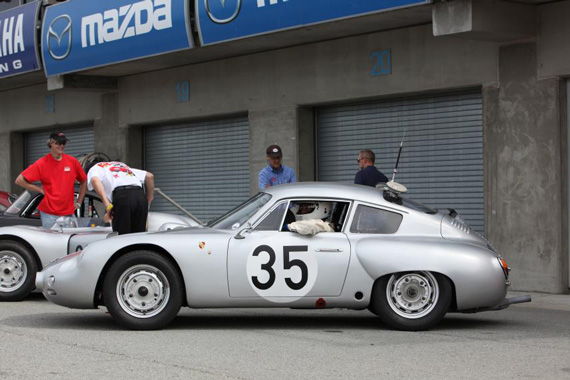
John Morton sits in the Collier Collection’s Porsche 356B Abarth Carrera GTL with his head and torso wired. Various parts of the car are electronically monitored as well, all in the name of research by the Revs Program at Stanford. The sending unit for the telemetry can be seen above the rear window. The event is the 2011 Porsche Rennsport Reunion at Mazda Raceway Laguna Seca.
Impressive Progress at the Revs Program at Stanford University
By Michael T. Lynch
Last week we spoke of the issue of disposing of one’s automotive ephemera, or at least the portion that has been unused for some time. The solution offered was Steve Fields Automobilia, which provides a service to do so through eBay.
This week we will discuss the question of donations of serious collections. I get at least two calls a week on this subject. The horror stories I have heard include going back to the donee later and finding that most of the donation has vanished or seeing the donated material ten years later in the same boxes in which it was delivered. While there are repositories that properly sort and index what they get, budgets, volunteer help and other issues do not usually provide a process that takes the gift from the box to a medium that can be distance accessed by researchers, let along the public. There is now such an institution.
In the August 10, 2011 edition of VeloceToday we filed a story on the launch of the Revs Program at Stanford, which brought together academics and other field experts from many disciplines at a symposium to discuss the past, present and future of the automobile. (Read the article.)
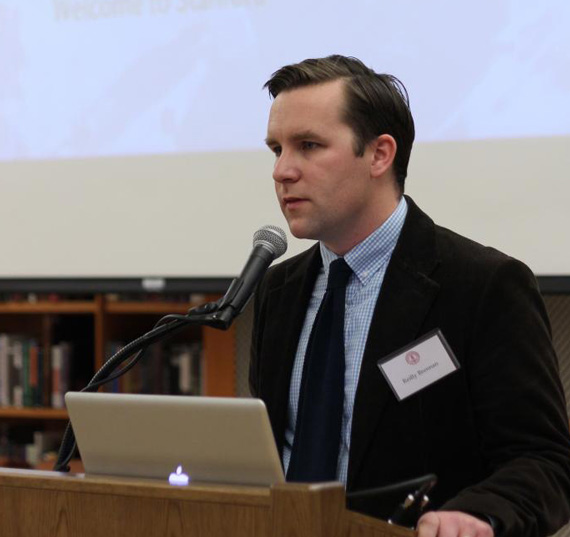
Reilly Brennan, Executive Director of the Revs Program at Stanford announces the acquisition of the Road & Track archive at a reception last December.
I should point out that the Revs in Revs Program is not an acronym for anything, despite what has been published elsewhere. Since our launch story, the program has made substantial progress, successfully introducing several initiatives in its attempt to broaden academia’s interpretation of the automobile’s place in society and encourage its study beyond engineering and design. Under Executive Director Reilly Brennan, who came aboard in February 2012, the number of automotive-related courses offered at Stanford doubled from the preceding to the present school year, with this year’s total at ten. Brennan says, “Our goal really is to bring the automobile to the center of Stanford and to fund and support smart people doing interesting and new projects with and about the automobile.”
An example of the innovative nature of some of the instruction is a course last fall that involved the restoration of a 1962 Cadillac Deville. The course description and a film about it can be seen below.
http://revs.stanford.edu/course/652
For something more traditional, the Anthropology Department is offering Car Culture this semester. It covers everything from how early automobile production processes ushered in mass production of other products to how cars influenced American courting practices.
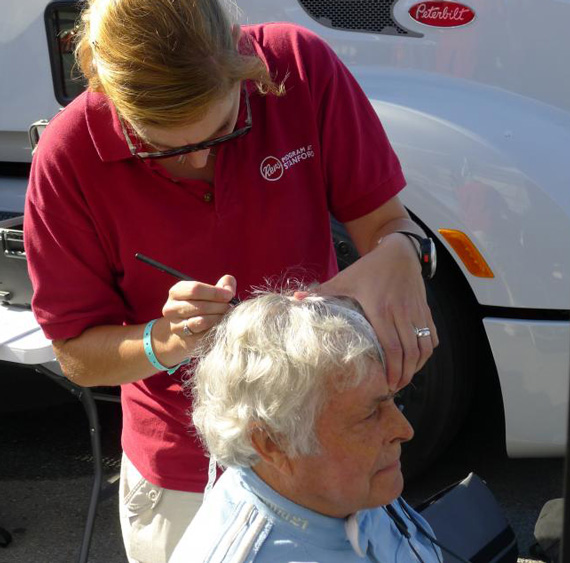
Researcher Lene Harbott prepares Brian Redman’s scalp to receive EEG terminals to track his brain waves during his race at the 2012 Rolex Monterey Motorsports Reunion at Mazda Raceway Laguna Seca. He drove a GT40 from the Collier Collection.
Another ongoing project, Exploring Driver Psychophysiology measures areas of driver reaction through EEG terminals on the body. The measured aspects of driver cognition are then overlaid with the car’s concurrent mechanical data as measured via telemetry. These data, taken from normal drivers on the street as well as from professionals on the race track, are intended to both define what makes some cars special, but also to gather information on how the driving experience can be made both safer and more fun. Professor Chris Gerdes oversees these efforts assisted by Researchers Lene Harbott and John Kegelman. Of interest to VeloceToday readers is the fact that several of the Collier Collection’s race cars have been put through this process at vintage races driven by such luminaries as John Morton and Brian Redman.
The Open Garage Talks brought personalities associated with cars to the Stanford campus. The remarks of Chris Bangle, former Chief of Design for the BMW Group can be seen here:
http://revs.stanford.edu/event/668
The series hosted Stefan Bradl, a German rider for the LCR Honda MotoGP Team who finished 8th in the 2012 World Championship on his RC213V. Also participating was Lucio Cecchinello, owner of the team.
Bringing intellectual heft to the series was Pulitzer Prize Winner, Paul Ingrassia, who discussed his book, Engines of Change: A History of the American Dream in Fifteen Cars. The book describes how each of the fifteen cars defined, and in some cases engendered, changes in American social habits. Thanks to the Stanford Libraries, Ingrassia’s presentation is available here: http://www.youtube.com/watch?feature=player_embedded&v=WmfoiOfiGtU
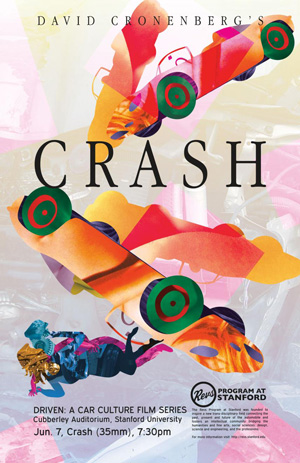
Another film in the REVS series was Crash, David Cronenberg’s controversial exploration of those who intertwine sex and car crashes. Despite the somewhat off putting subject matter, Crash won a prize at the Cannes Film Festival.
Few communications media are as universal as the movies, and Revs also hosted Driven: A Car Culture Film Series. It included everything from Film Noir (Armored Car Robbery) to the usual tales of wayward drag racing youth (Two-Lane Blacktop — James Taylor was wonderful – and American Graffiti). Art Film was represented by Trafic, the last in a comic series that featured Monsieur Hulot, the fabulous character played by gifted French mime, Jacques Tati, who also directed. The title itself is a joke in Franglais, the amalgam of English and French that French social commentators so despise. There were other movies, equally interesting.
The Revs Program saved the best for last and made its most impressive announcement to date on December 11 at a reception at Stanford’s Green Library — the acquisition of the Road & Track archive.
Since its inception in 1947, Road & Track has been the magazine of record of American automobile enthusiasm. Like the finest special interest magazines of the 20th Century, R&T used writers, artists and photographers whose influence went well beyond the subject of the magazine. It championed foreign cars and railed against the excesses of U.S. automobile design when such ideas were considered un-American. Travel articles often covered European trips, many to the factories that built the automobiles the writers owned.
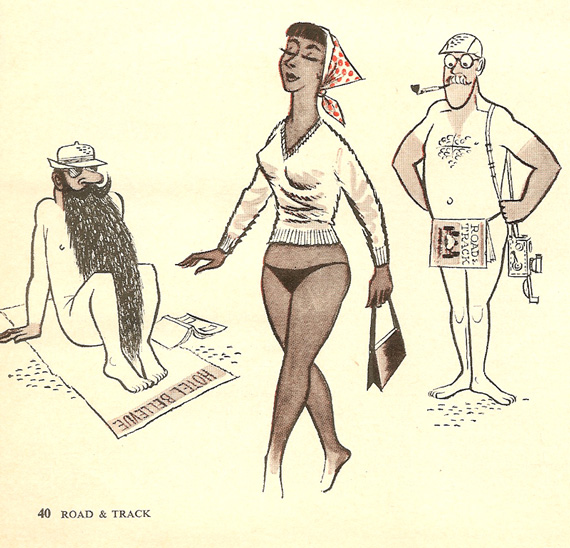
Artist Russell Brockbank provided the fanciful illustrations for Henry Manney III’s comic travelogue to the Île du Levant. Manney is depicted with his camera and a Road & Track magazine as part of his costume.
One legendary article was An Incompleat (sic) Guide to the Île du Levant by a much-loved writer, Henry Manney III. 90% of the French island in the Gulf of Lyon is devoted to off-limits military use and the remainder consists of a naturalist village complete with city hall and a government. Clothes are not welcomed. The images in the piece were limited to illustrations, for decorum; no photographs were used.
The Stanford Libraries are already considered to be the repository of some of the finest history of technology collections in the world. These date from Stanford founder Leland Stanford’s contribution of the Southern Pacific Railroad’s business and technical records. The Road & Track material will both provide a foundation for an automotive archive and a magnet for other auto-centric collections to be added over the years.
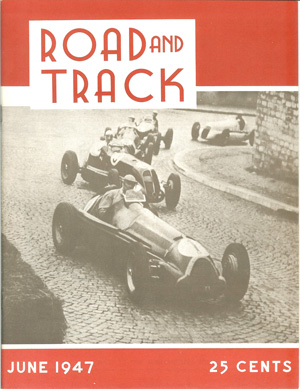
The Road & Track archive of course includes the first issue. The going was rough at the beginning and it would not be until January 1950 that two issues came out in consecutive months. Note use of the word 'and' in the title instead of the later ampersand. That was not used until the March 1954 issue. Terry Galanoy, who oversaw that change of graphics was at the reception announcing Stanford’s receipt of the archive.
Henry Lowood is the Curator for the History of Science and Technology Collections in Stanford Libraries. He says, “An important part of our mission is to provide long-term access to archives and unique collections, whether they originate with individuals or organizations, The Road & Track archive will find a place among our collections that document the history of companies ranging from the Southern Pacific Railroad to Apple Computer.” This is fitting because most top ten lists of 20th Century inventions list the automobile in the lower half. Perhaps Stanford can move us up a few notches.
All this will enhance the Revs Program’s ability to lead all academic institutions in integrating the study of the automobile into areas of intellectual inquiry where cars have been previously been given short shrift, if not ignored.
Road & Track was moving their office to Michigan and their new premises did not have room for the archive, which was stored in a garage. Stanford engaged the magazine and discussions began. Henry Lowood visited the magazine with Mark Patrick, the Managing Librarian and Archivist from the Revs Institute in Florida. They were amazed by what they found. The treasure trove was hardly limited to back issues but included photography, illustrations, reporter’s notes, engineering test data, and correspondence. Examples included folders with specific road test information along with testers’ notes and gas receipts.
Lowood and Patrick, who could hardly contain their enthusiasm, called Reilly Brennan who began building faculty and administrative support to get the collection to Stanford. A group came together including Revs Director Clifford Nass, Revs Co-Director Michael Shanks, Art & Art History Chair Nancy Troy, STS Director Fred Turner, Professor and design firm IDEO founder David Kelley and Assistant University Librarian for Special Collections Zachary Baker and University Librarian Mike Keller. Wendy Israel and Larry Webster provided support and guidance from the Hearst and Road & Track side of things. When the collection left Newport Beach, there were 527 boxes weighing five tons and required two moving vans.
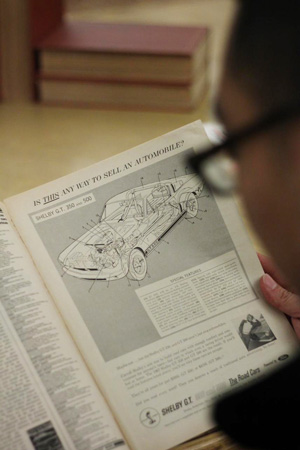
At the Road & Track reception, Researcher Jackie Laio checks out a late 1960s issue with an ad for the Shelby Mustang GT350/500.
Even Stanford can only do so much. The digitization of the Road & Track collection and posting it on the Stanford site is in the future. That future can arrive sooner with the support of the automobile industry as well as interested individuals. If you want to tell your grandkids that you, “helped save the Road & Track archive”, here’s your chance.

R&T used to religiously keep track of articles from the very beginning through an annual printed index. They were about the only automotive publication professionally indexed. When Stanford organizes their collection they should be sure to include these indexes which were were very well done and valuable to researchers. Today’s on-line indexes aren’t very good because they are taken from tables of contents and not from information in the articles. I didn’t know Stanford had any interest in automotive history. Regards, Jack Middleton
Thanks for your reporting on the archive. This is great news, although the reminder that R and T has moved to the Detroit area is a bitter reminder of how much the magazine has strayed from the vision of John and Elaine.
Peter,
In my archives is a complete, original collection of Road and Track. It includes of course, the original Vol 1 #1.
Speaking of archives, in 1971 I was swindled out of a one cubic foot box of Porsche factory literature from the very first advertising brochures till 1961. The “sweet talker” was the son of the first publisher of R&T. I wonder what the contents of that box is worth now!! It included lots of personal correspondence from Klaus von Rucker and Jochen Peiper ( you can look up those names)
Jerry Lehrer
La Jolla, California
I am happy to see that the R&T archives will be appreciated by students and historians at Stanford. However, as a 40 year R&T subscriber, I am deeply disturbed by the manner in which the magazine abandoned it’s heritage, SoCal roots, and staff members – most of whom were fired after decades of service. John R Bond must be spinning in his grave.
I hat to agree wholeheartedly with Lagunatich. I can’t imagine R&T emanating from any locale other than Southern California. I am happy however, that Stanford is helping to preserve some of the history. Another reason I appreciate Stanford University!
I hope the transfer takes place quickly. I don’t give the “new” R&T a year before it gets wrapped into Car and Driver. I finally let my sub (started in 1966) go this year. Hopefully Peter Egan will alight somewhere.
An in-depth article on the joint Stanford University/Collier Museum Revs Project
will appear in the next issue of Excellence – The Magazine About Porsche.
It should also be noted that Miles Collier has given Stanford the task of digitizing the Collier Museum library’s vast collection of automotive documents and photographs.
Interesting news. The first sports car magazine I ever bought – and still have, was R & T around Dec. 1960. R & T fueled my “car dreams” for a long time thereafter. Of course, I stopped buying it when it drifted away from it’s sports car and racing format. The other day, I picked up the current issue at my book store – for the first time in – I don’t remember how long, and found it to be approx. 1/3 the thickness of back-in-the-day. I didn’t even thumb through it. Such a shame. I really miss Henry Manney and articles on ephemera such as little Abarths.
Joe Dunlap
Florida
While I am delighted to hear that Stanford is taking the Road & Track archives it does make me wonder as to what the new “Detroit” R & T will use for research material. After all we have all been told that those who ignore history are destined to repeat it………………..
An in-depth article on the Stanford University/Collier Museum’s Revs Project will appear in the next issue of Excellence – The Magazine About Porsche.
Thank you Michael for bringing us all up to date on Stanford REVS. I attended the Continuing Education class hosted by Prof. Shanks this fall and was very impressed. Reilly was a guest lecturer as was Prof. Nass and Kelley. As a side note, REVS as let us in on conversations with students and Professors such as Gordon Murray and Luca di Montezemolo. Bring down the Cabernet and I’ll share my class notes
This is good news that the R&T materials have landed in a safe and sympathetic organization. I have long thought that R&T wasted an opportunity to make back issues available digitally, or to create collections of articles based on themes, manufacturers, or events. Such a squandered opportunity over time! And I share the scepticism that R&T will ever represent its founding principles and direction. Has anyone looked at the new R&T web site? What a jumble. Many thanks to Stanford REVS for their foresight and efforts.
When R&T-1 landed my head was still looking for a 3-window deuce – already virtually extinct in the wild.
It would be 7 years until I walked past a Grand Opening event wherein was displayed a then-new Austin-Healey 100 BN1, windscreen raked, in BRG over tan leather.
I never looked back. Gone were my rod pubs, their place immediately devoted to R&T and more centrist pubs that offered some furrin’ car coverage.
So, by the time I came to know R&T it was the quintessential Bond R&T – complete from SoCal with Elaine managing, John crafting and Henry Manny III for ‘color’.
After Elaine’s death and then John’s, R&T began drifting off course and the move to Detroit was, of course, a chicane that should have been less traveled.
My first Bond-definition Sports Car was a ’62 Giulia I picked up at the Milan office and brought back to Detroit (we couldn’t all live in Sunny SoCal). I would own one more Detroit product: a Mustang GT convertible. Since then it has been MGs, Jags, a Capri (more Detroit than German), various Datsuns, Nissans, Toyotas, Lexi and the first Honda Z coupe in Arizona – two years before Toyota first outsold Chevy in L.A. County and Detroit slept on, calling it an ‘aberration’. Some aberration!
The Bond’s R&T was, is, and doubtlessly always will be my ideal, favorite, don’t -mess-with-it car mag.
I fear we shall never see their – or its – likes again.
More’s the pity – it was the best of lines.
It is some small comfort to know their archives will be preserved – somewhat like having the ashes of a favorite pet on the mantle.
While I enjoyed reading the comments and agree with many of the criticisms, my gut feel is, thank goodness the archive is being safely preserved and will be scanned and available.
Not to take anything away from Stanford, their new interest in archiving automotive material is to be commended…
However, Watkins Glen has the International Motor Racing Research Center, which started as a small collection in the corner of the town library many years ago (1980’s?). They built their first building (all from private money) in 1998. They already have a huge amount of racing related material and recently acquired the archives of Chris Economaki – National Speed Sport News. As a working research library, they assist authors and others worldwide on a regular basis. They have a regular lecture program (generally free to attend). Many historic movies/videos are also in the collection and there is a screening room available.
http://www.racingarchives.org/
Interesting to here about R&T , yes I also have a complete collection of R&T from the 1st one 1948 to the late 80 when it no longer followed my interests, I also purchased from John Bond both of the FERRARI’s that he had from the 50’s a 250MM and a 166 mm Berlinetta both from John Bond, but what is very important is that I bought the estate of Dean Batchelor who was editor of R&T from 1959 to 1965, and Dean estate consists 100 of thousands of negatives & prints of anything that R&T during his time as editor, including just going over a few things, I just found a new 1951 brake drum from the Alfa-Romera G/P car, I am at present having it mounted on my car room to go along with other parts of HISTORY that I have collected for over 50 years.
Road & Track..1st issue..only 6000 copies printed..1500 on sale New York City, another 1500 in Los Angeles…tghe balancve of 3000..? sold in bulk to used book dealer on Long Island when founder Bill Brehaut moved to Burebank and Lockheed Aircraft in 1948…..un sure what became of the remainder. this from our lunch for 50th anniversasary in 2007 in Palm Springs. I ‘ve been reader since ’48
founder Bill Brehaut told me how he printed ONLY 6000 copies..1500 sold in NYC, another 1500 in Los Angeles..balanmce sold in bulk tyo used book store on Long Island and their fate ” unbknown”..trhis i learned during our lunch st his Palm Springs home in 1997. Bill lost control of magaziner end of 1952.
Jim Sitz
Oregon
From Brazil I love to say R&T was always my favorite. I’m really glad to see this so important Stanford to have a movement towards automotive culture from past and future.
Congratulation for all the team involved.
Hi Jerry Lehrer,
My grandfather is Klaus von Ruecker. Do you have any other articles, etc on his work/efforts?
thank you
Mike
Is Auto Week (now bi weekly) what R&T used to be? Less glossy, much sharper reporting, sense of humor as well.
I am very pleased to have discovered that so much of this material was saved, after the notorious move of R&T to Michigan. I say notorious because the powers that be who took over R&T showed nothing but utter contempt for it’s glorious history and for many of the staff and free lancers (that would be me) who contributed to the magazine for decades. I wouldn’t touch a new issue of R&T, much less buy one, but then, this great publication wouldn’t be the first to be turned into little more than a commodity. Art Director Bill Motta always encouraged us to strive for perfection and to do our best, an ethos I’m sure the new owners find rather quaint.
Kudos to Stanford for doing this. I may contact them by acquiring my cartoon art collection, spanning 20+ years of work for R&T. JT 6-16-2016